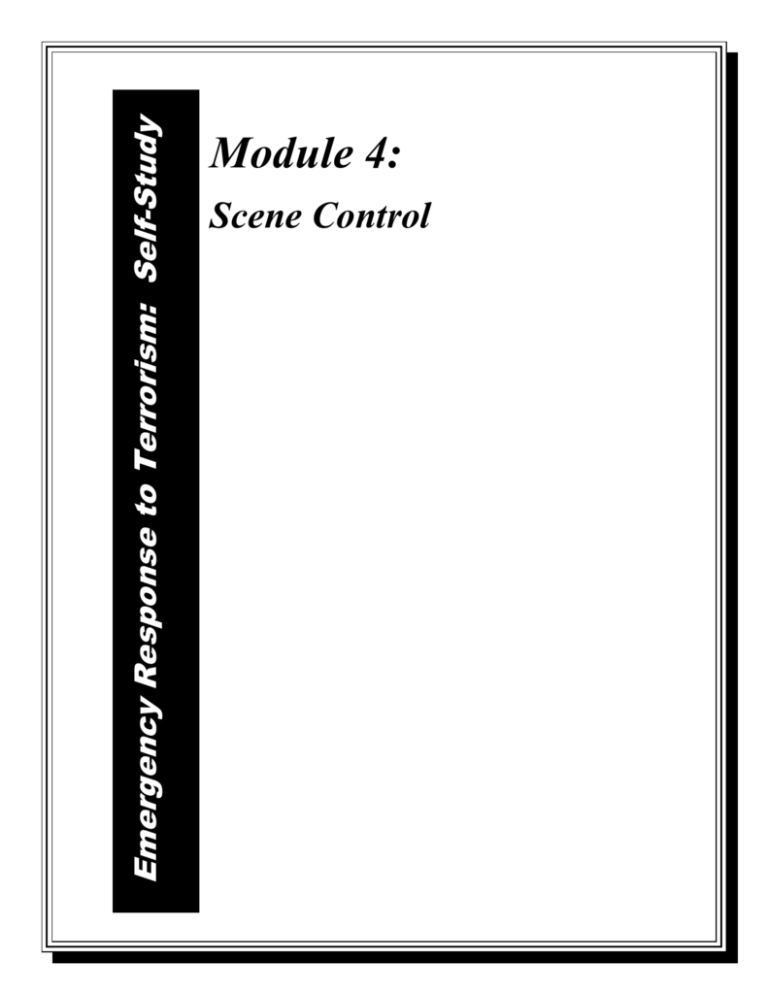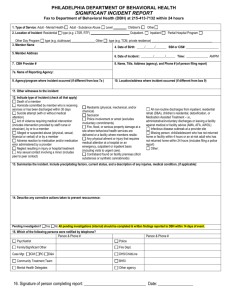Module 4 - DISASTER info DESASTRES
advertisement

Emergency Response to Terrorism: Self-Study Module 4: Scene Control ERT:SS Module 4 - 40 - ERT:SS Module 4 decisions identify the overall approach to the incident, and operational decisions spell out the best use of those resources. Objectives After completing this module, you will be able to: During routine emergencies, most firefighters follow a standard approach: performing sizeup, choosing a strategy, implementing various tactics, and conducting ongoing evaluation. explain the need for an Incident Command System (ICS); list the steps or processes traditionally associated with responding to an emergency; and name and explain the nine common steps of the planning process. In recent years with an increased emphasis on nonroutine incidents such as hazardous materials, and now terrorist events, other methods have been developed to address new aspects related to nonroutine situations. In these situations it is especially critical to know exactly what steps to take and the sequence in which they must occur because of the presence of hazards other than those traditionally encountered. For example, during a bombing you may find it difficult to determine an appropriate course of action due to the nature or the magnitude of the incident. Furthermore, you may feel extreme pressure to act. INCIDENT COMMAND Experience has shown that those incidents managed in a systematic way are the most successful at achieving the intended goals. Incident command deals with the Incident Commander (IC) and his/her staff making operational decisions, some strategic, others tactical in nature, and carefully allocating resources to implement them. As a first responder you need to understand the role of the IC as the ultimate decisionmaker responsible for the outcome of the incident. Regardless of the specific process used, responders go through a number of similar steps in dealing with their response. Five common steps include conducting sizeup, evaluating the situation, setting incident priorities, estimating potential incident course and harm, and choosing strategic goals and tactical objectives. The ICS is the framework necessary to manage the resources, personnel, apparatus, and equipment, used to mitigate the incident. Strategic Thinking About My Situation… Have you ever been in a situation where you were, even for a short time, the IC? [ ] Yes [ ] No If so, did you consciously handle the incident using an ICS or did you operate without one? What are the risks of operating without an ICS? - 41 - ERT:SS Module 4 Conducting Sizeup military studies its enemy prior to battle and constantly evaluates its battle plans, so should you. Sizeup, the rapid mental evaluation of the factors that influence an incident, is the first step in determining a course of action. For many responders it begins even before the incident in the form of preplanning. The more information you have prior to the incident, the greater the chances of having a safe and successful response. Incident situation refers to the type, the cause, and the status of the incident. The type of incident refers to whether it is one of the five types of incidents discussed in Module 1 (a chemical attack, an explosion, a fire, etc.). The cause of the incident refers to whether it is an accident, such as a system failure, or something intentional, such as a bombing. The incident status refers to whether the incident is in a somewhat controlled state (static) or is still uncontrolled (dynamic or expanding). Evaluating the Situation Incident factors are dynamic and must be evaluated continually. Therefore, in a sense, sizeup continues throughout the incident. In the same way that the Thinking About My Situation… Do you agree with this statement? "Evaluating the situation is not something a responder does consciously. By virtue of training, the responder is constantly evaluating." [ ] Yes [ ] No Do you think injury and fatalities could result from a lack of proper evaluation? Do you know of any instances where this may have occurred? What might have prevented the injuries? Setting Incident Priorities incident will take and the probable harm or damage that is likely to occur. For example, if faced with an explosion, you should be concerned about the possible presence of a secondary device that may cause harm to personnel or create additional property damage. Incident priorities include life safety (for the responders as well as the public); protecting critical systems (such as the infrastructure, including transportation, public services, and communication networks); and incident stabilization. Choosing Strategic Goals and Tactical Objectives Estimating Potential Incident Course and Harm Strategic goals are broad, general statements of the desired outcome. An example of a strategic goal would be "to prevent loss of life for both civilians and responders." Potential incident course and harm includes a series of predictions based upon the incident situation and available information. The responders estimate the probable course that the - 42 - ERT:SS Module 4 Tactical objectives are specific operations or functions to meet the goal. For example, to meet the strategic goal of preventing loss of life, you should "isolate the hazard area and deny entry into that area." in dealing with the range of potential incidents that are the focus of this course. GEDAPER There are seven steps to this process: Tactics are the specific steps and actions taken by the assigned personnel to meet the determined objectives. For example, to accomplish the tactical objective of isolation, you could "position apparatus in such a fashion as to block the area, and cordon off the area with banner tape." Notice that at each level there are more specifics involved. In the case of the tactical methods, using the apparatus and cordoning off the area are only two possible approaches. 1. 2. 3. 4. Gathering information. Estimating course and harm. Determining strategic goals. Assessing tactical options and resources. 5. Planning and implementing actions. 6. Evaluating. 7. Reviewing. Gathering Information As a first responder, you need to gather as much information about the incident as possible (a first responder in PPE, including positive pressure SCBA, could only use sight and hearing) through observation, using the senses. Given the likelihood of the presence of hazardous materials at a terrorist incident, it would be in your best interest to observe from a distance, using only the senses of sight and hearing. The use of touch, taste, or smell could result in exposure. Influence of Hazardous Materials In recent years the Federal government has enacted laws and developed regulations that require emergency services personnel to receive proper training. This legislation grew out of the realization that hazardous materials incidents differ from the more traditional incidents that historically have been the "bread and butter" of the fire service. This training is organized around five levels: Awareness, Operations, Technician, Specialist, and Incident Manager. Your education, training, and experience will help you evaluate this information before going any further. Today, there are numerous information resources available in hard copy or electronic format. If you cannot access this information at the scene, contact those who can access it for you. For instance when the term "mass casualty incident" is used to describe an incident scene, you can relate to the situation automatically. The term triggers a mental assessment based on education, training, and experience. This is unavoidable. On top of this there are other layers--perhaps many-of technical information (data) provided by other sources, commonly including texts, computers, preplans, floor plans, etc. For example, if responding to an incident involving hazardous materials (B-NICE), the first responder may In implementing its training programs, the National Fire Academy (NFA) has followed these classifications. Furthermore, the NFA has adopted for its hazardous materials curriculum an incident analysis process called GEDAPER (developed by David M. Lesak). In doing so, the NFA is saying that the seven steps of GEDAPER provide the responders the needed processes for analyzing and handling a hazardous materials incident safely and prudently. It also is the view of the NFA that this same tool, although not the only one available, can be very helpful - 43 - ERT:SS Module 4 consult the North American Emergency Response Guidebook for recommendations on initial isolation and protective action distances. There are other types of information that will assist you as first responder: information received from your dispatcher, such as type of incident, incident location, number of reported casualties, etc., that could indicate a possible terrorist incident; information obtained during your sizeup, such as unusual signs and symptoms, presence of dead animals or people, unexplained odors, unusual metal debris, placards or labels, etc. (outward warning signs and detection clues); and environmental information, such as time of day or night, location (address, neighborhood, and occupancy), weather (temperature, wind direction, relative humidity), topography (lay of the land, hills, bodies of water), and exposures (people, property, environment). Regardless of the incident, the first step is to collect all the information possible as quickly as you can before you go any further. Then, once you have made some initial decisions, you need to continue to collect information and reassess it. Thinking About My Situation… Recall a recent incident that you have participated in as a first responder, preferably a hazardous materials incident. List a few specific steps of information gathering that you took. Did you consult any printed sources? If so, name two or three. Did you refer to any other resources that were not at the scene for additional information using a radio, telephone, or other electronic device? If you did, how helpful was this? and risk determination. Damage assessment involves figuring the damage that has already occurred. Hazard identification means determining what product is involved, where it is, what it can do, how much there is, etc. Vulnerability assessment is figuring out who and what is at risk, in other words, all persons and things Estimating Course and Harm Estimating the course of an incident involves using the information you have gathered to make a series of predictions and to assess the potential harm. This involves damage assessment, hazard identification, vulnerability assessment, - 44 - ERT:SS Module 4 the hazard may affect. Risk determination involves estimating the probability that the situation might get worse before it is controlled. Initially, strategic goals and tactical options should be based on the most likely situation outcome. Perimeters and zones represent a safety factor, or buffer, against the hazards presented by the incident. The establishment of zones, or perimeters, is critical to protect both first responders and civilians. Denial of entry includes the use of physical barriers, such as tape, rope, barricades, etc. These tasks are within the scope of responsibilities of a first responder trained to the awareness level. Determining Strategic Goals Strategic goals are broad, general statements of intent. Always to be included in determining strategic goals are the incident priorities of life safety (responder and civilian), protection of critical systems (anything that is in place for the betterment of the community, such as public utilities and transportation, hospitals, etc.), and incident stabilization. Public protection involves establishing an area of safe refuge for those who are contaminated, thus reducing the chances of secondary contamination. It also involves assisting those individuals who are in harm’s way to safety. Doing so will set the stage for decontamination and subsequent medical treatment. All of these objectives require the use of resources, including personnel and equipment. The level of effort required, coupled with the amount of resources available, will determine if the goals and objectives can be attained. If the resources are adequate, or if other assistance is available, then the next step, planning and implementing actions, becomes possible. Assessing Tactical Options and Resources In order to meet the strategic goals, you need to select appropriate tactical objectives and methods. For instance, if the strategic goal is isolation, then the tactical objectives must include establishing perimeters and operational zones, denying entry into the "hot zone," and removing the public and emergency personnel far from the "hot zone." Withdrawal is an option where the situation is too dangerous or too large for intervention. The best course of action may be to evacuate the area, deny entry, and allow the incident to run its course. Thinking About My Situation… Do your local SOPs/SOGs address issues such as establishing operational zones and perimeters (public protection)? If so, what specific issues are addressed that involve the efforts of first responders? Planning and Implementing Actions The plan of action is a written document that consolidates all of the operational - 45 - ERT:SS Module 4 actions to be taken by various personnel in order to stabilize the incident. It is important for you to appreciate the purposes of the written plan. It helps pinpoint the exact actions planned. decontamination considerations, EMS concerns, and similar safety issues. When the incident involves chemical or biological hazards it assists in fulfilling employee right-to-know requirement. Standard operating procedures/ standard operating guidelines (SOPs/ SOGs) are linked to the plan of action. They spell out the functions, roles, and responsibilities of personnel on the incident scene. They should be agreed upon long before the incident, and the staff must be trained in implementing them. The plan of action references SOPs/SOGs, it does not create them. The site safety and health plan helps to document the specific actions and safety procedures used. It will assist in documenting whether the chosen plan of action and the specific procedures are followed. In addition, the site safety and health plan tracks activities and performances and assures that personnel safely perform those tasks for which they received appropriate training. Someone trained only to the Awareness Level should not perform tasks specific to the Operations or Technician Levels, for example. Another important planning step is to create a "site safety and health plan." If the incident involves hazardous materials, which most terrorist incidents will, Federal regulations (OSHA 1910.120) require that you to create one. A site safety and health plan is a series of checklists used to manage an incident and to assure the safety of all involved. Like SOPs/SOGs, the checklists are developed before the incident and are implemented during the incident. Included in the site safety and health plan are the location and the extent of zones, the nature of the hazards found on the scene, the types of personal protective equipment (PPE) worn by personnel, and the type(s) of decontamination procedures followed. Your local or State hazardous materials responders should have examples of existing site safety and health plans that can be adjusted to fit a terrorist scenario. The site safety and health plan identifies the health and safety hazards faced at the incident scene. It further identifies appropriate PPE, Thinking About My Situation… To which level are you trained? Have you ever operated beyond your level of training either of your own volition or because an officer told you to? [ ] Yes [ ] No Apart from the legal implications, what are the safety implications? - 46 - ERT:SS Module 4 an extended response period and it is not wise to wait until the entire operation has concluded. If the entire process is managed effectively from the start, there should be no problems with the plan of action. Specifically, if the information gathered initially is thorough, comprehensive, and well managed, the estimate of course and harm should be accurate and the strategic goals and tactical objectives chosen also should be appropriate. Evaluating The goal of the evaluation process is to determine whether the plan of action is working as intended. Evaluation will help identify possible errors and allow the responders to correct them. You should monitor and evaluate all incident scenes, terrorist or not. If your plan is failing rapidly, you will need an alternate plan of action that can be implemented quickly and, depending on the available resources, used to solve the problem. It is foolish to stick with a plan that is not working. If problems are discovered with the plan, then the existing plan should be modified to reflect the appropriate changes, or a new plan should be developed to replace the flawed one. In summary, the plan tells what should be, the evaluation tells what is not, and the review makes the corrections. Ongoing evaluation assures that the plan is working or alerts you that the plan is failing. Reviewing The review process involves revisiting and confirming the GEDAPER process. Review occurs either when strategic goals are accomplished or when there is Thinking About My Situation… How often have you been involved in reviewing the incident action plans? What were some of the benefits of this review process? Did it make a difference on the final outcome? Dependent upon the situation you find upon your arrival, coupled with prearrival information such as the incident location and situation as dispatched, you will need to make early decisions that will affect the incident. Always keep in mind the outward warning signs and detection clues mentioned in Module 2. Onscene considerations should be similar to your existing response guidelines dealing with hazardous materials. While it SUMMARY While you may not be faced with being the IC, it should be obvious that your role as a first responder is critical to the management of the incident. Remember that the actions you take and the decisions you make early in the incident will have a dramatic effect on the outcome of the event. One of the first concerns you should address is your safety. - 47 - ERT:SS Module 4 would be easy to become overwhelmed, keep in mind the following key points: Your safety and that of your fellow personnel is paramount; otherwise you cannot possibly mitigate the incident. The initial steps of gaining control of the scene will greatly affect incident management. Simple procedures, such as staging apparatus uphill and upwind, performing isolation, and establishing perimeters, will help immensely. This may be all you can do prior to the arrival of additional resources, but do not minimize its importance. You need to be proactive, not reactive. In other words, try to stay a few steps ahead of the current situation to be better prepared for what may occur next. Remember also that you are only human and that you can do only a limited number of tasks simultaneously. Although you may be overwhelmed initially, eventually your actions should overcome the seemingly chaotic situation and the incident will be under control. Plan to be a part of the solution, not part of the problem. Do not hesitate to seek additional assistance. What I Will Do As Followup To This Module… Describe one or two practical, achievable steps you will take as a result of studying this module to help you to be better prepared to deal with one of the incidents described here. Step One: Step Two: How I will accomplish Step One How I will accomplish Step Two - 48 - ERT:SS Module 4 LEARNING CHECK True or False: Circle either T or F. 1. T F As a first responder, your initial concern should be the safety of others, not yourself. 2. T F All emergency operations must be organized to be successful. 3. T F A system is a collection of unrelated, independent parts designed with no particular purpose. 4. T F Improper emergency scene management can result in loss of scene control, but not greater loss of life or injury. 5. T F Strategic goals are broad general statements of the desired outcome. Multiple Choice: Circle your answer. 6. This plan documents specific actions and safety procedures used. Tracks activities and performances, and assures that personnel safely perform those tasks for which they received appropriate training. a. b. c. d. 7. During the review step in the GEDAPER process, you should a. b. c. d. 8. determine the location and extent of zones, the nature of hazards found on the scene, and the types of PPE required. develop a site safety and operational plan. revisit and confirm the proceeding steps in the GEDAPER process. establish the cause and status of the incident. When estimating course and harm during the GEDAPER process, you would a. b. c. d. 9. Plan of action. SOP/SOG. Site safety plan. Employers Emergency Response Plan. assess damage. establish perimeters. determine life safety priorities. assess resources. When gathering information during the GEDAPER process, you would a. b. c. d. develop SOPs. establish the number of casualties. develop SOGs. select appropriate tactical objectives and methods. - 49 - ERT:SS 10. Module 4 If an incident involves hazardous materials, which most terrorist incidents will, Federal regulations require you to create a. b. c. d. an evaluation tool. a site safety plan. a risk determination. none of the above. Answers are provided at the end of this Guide on page 105. - 50 -









